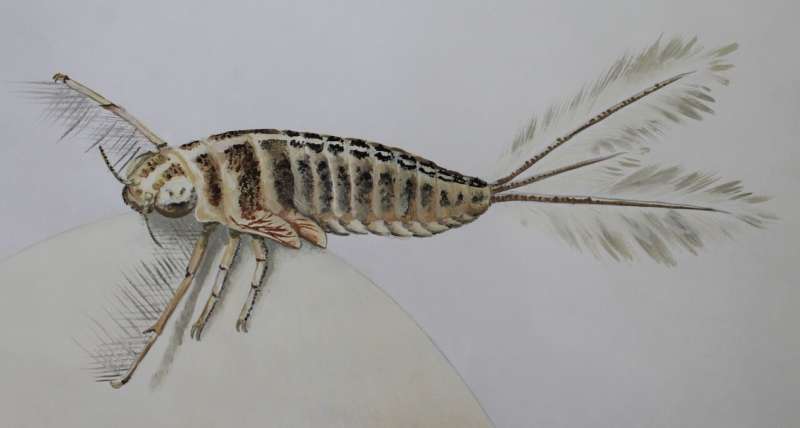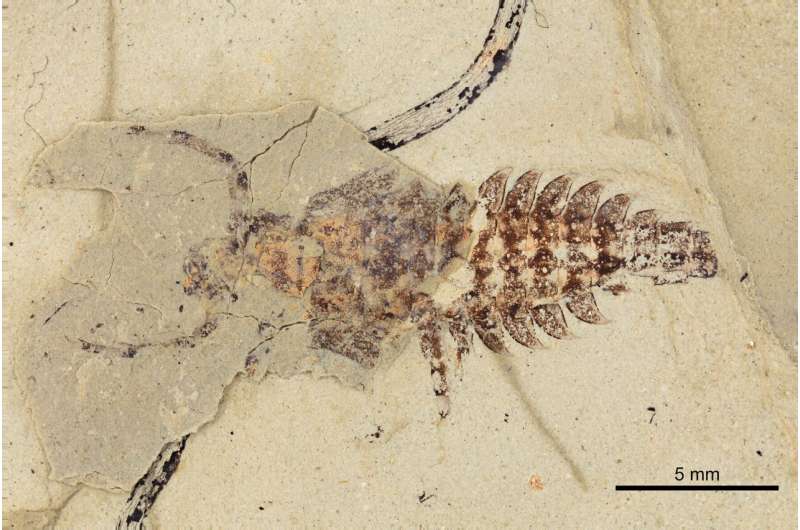245-million-year-old fossils provide new insights into the evolution and feeding strategies of aquatic insects

The feeding strategy of filtering suspended particles from the water was developed earlier in aquatic insects than previously assumed. This was revealed in a study on fossil insect larvae from the 245-million-year-old Grès à Voltzia sandstone of the Vosges Mountains by Dr. Arnold Staniczek, specialist on aquatic insects at the State Museum of Natural History in Stuttgart, and his colleague Dr. Pavel Sroka from the Czech Academy of Sciences in České Budějovice.
Until now, the mode of life and the systematic classification of these animals were controversial. Based on a character analysis, the scientists were able to prove that the fossils are aquatic mayfly larvae that lived as passive filter-feeders in flowing waters as early as 245 million years ago during the Triassic period. These findings provide the earliest evidence to date for the occurrence of this feeding strategy in aquatic insects. Previously, it was assumed that this feeding strategy appeared in mayflies not before the Jurassic period, about 200 million years ago, and in caddisflies in the Cretaceous period, about 135 million years ago. The three fossil species studied, Vogesonympha ludovici, Mesoplectopteron lonigpes, and Triassoephemera punctata, were placed in a new systematic group called Sinebranchia, closely related to modern mayflies.
The results of the study were published in the journal Papers in Palaeontology.
The specialists' analyses focused on three fossil species of a diverse mayfly fauna from the 245-million-year-old Grès à Voltzia sandstone of the Vosges Mountains, France. To their surprise, the researchers discovered, in previously unstudied specimens, that a remarkable diversity of insect life strategies and diets existed in the Middle Triassic. The most obvious adaptations of these insects to their feeding strategy are a filtering apparatus of long filtration hairs on the forelegs, arranged in rows, and filter hairs on the mouthparts, which were used to filter out suspended particles from the water as nutrition.
"Also characteristic of the larvae described is their loss of tracheal gills, which was probably related to their living in flowing, well-oxygenated water, so that gills became superfluous. This new way of feeding at the beginning of the Mesozoic was possibly related to an increasing amount of small organic particles in the freshwaters. This also provides us with information on the ecosystem at that time," says Dr. Arnold Staniczek.

The analyzed fossils are part of the valuable Grauvogel Collection from the Middle Triassic Grès à Voltzia sandstone of the Vosges Mountains. "The excellent fossilization of these insects gave us the opportunity for extensive analyses. Numerous insects have been preserved in the Grès à Voltzia sandstone; otherwise, there are only extremely few finds known from the Triassic," says Dr. Staniczek.
In its entirety, the Grauvogel collection documents a subtropical delta that was located in Central Europe 245 million years ago and provided a habitat for many previously unknown species. This is of great scientific value to researchers from a wide range of disciplines.
More information: Pavel Sroka et al, Evolution of filter‐feeding in aquatic insects dates back to the Middle Triassic: new evidence from stem‐group mayflies (Insecta, Ephemerida) from Grès à Voltzia, Vosges, France, Papers in Palaeontology (2022). DOI: 10.1002/spp2.1456
Provided by Staatliches Museum für Naturkunde Stuttgart




















